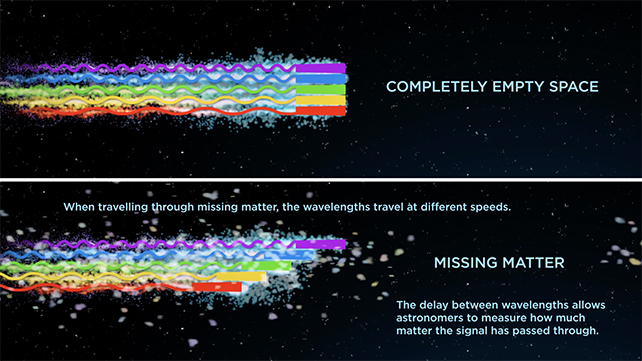A particularly bright flash of radio waves that has been traveling through the Universe for more than 8 billion years is proving difficult to explain using current leading theories.
An international team of researchers spotted the fast radio burst using the Australian Square Kilometer Array Pathfinder (ASKAP). Dubbed FRB 20220610A, the event stands out for a number of reasons.
Not only has it journeyed considerably further than most FRBs on record, it is incredibly energetic – exceeding the maximum set by previous models by a factor of 3.5.
The researchers' analysis showed something else unusual, too. A measure of the spread of wavelengths referred to as its dispersion measure also didn't quite match expectations, prompting a rethink on the assumptions astrophysicists make when they use these phenomena as tools to study the Universe.
Since their discovery back in 2007, barely a few dozen FRBs have been observed, making these intense, millisecond-long bursts of radio waves rare events. Most seem to be one-off, with a few repeating in ways that are reminiscent of earthquake aftershocks.
The analogy might be more than skin deep. It's possible the emissions are produced by neutron stars as their pressurized contents shift, tugged out of shape by their own powerful magnetic field.
The forces involved would explain why FRBs blast with the energy of hundreds of millions of Suns in a mere blink of the eye. Yet it also sets a limit on the light's intensity, a limit this latest example exceeds.
The brightness of FRB 20220610A also outshines models that propose the bursts of radio waves are created when high-speed particles associated with neutron star flares smash into surrounding stellar winds.
While the researchers rethink the ways FRB 20220610A and other unusually energetic FRBs might form, the observation is also defying a completely different set of expectations involving the way its light appears to spread through intergalactic space.
Zipping through pure emptiness, light travels at the one record speed. This all changes when its waves pass through electromagnetic fields, with different wavelengths of light interacting with the field in subtly different ways. The result is as familiar as a rainbow after a storm; a spectrum of wavelengths teased apart by a shower of transparent droplets.
Similarly, the gas and dust that floats through the interstellar and intergalactic vacuum carries its own faint electromagnetic buzz that causes wavelengths to slow at different rates as they shine through.

Several years ago, Australia researchers proposed the burst of light from FRBs could be used to measure the diffuse fog of material floating between the Milky Way and nearby galaxies, serving as a method for measuring both the density of 'hidden' non- dark matter and the expansion rate of the Universe.
The dispersion measure increases with distance in a set manner known as the Macquart relation. This relationship has held true for most FRBs within a few billion light years, with one single shining example.
A repeating burst detected last year in a dwarf galaxy just under 4 billion light years away had a dispersion measure that corresponded with sources more than twice that distance.
With FRB 20220610A also bucking the Macquart relation, it's clear some dispersions are a little more complicated than others.
After taking a closer look at other characteristics of the light, the researchers suggest a cosmic storm of turbulent, magnetized plasma brewing between here and the more recently discovered FRB's source – most likely within its host galaxy – has messed with its spectrum.
FRBs are proving to be incredibly powerful tools in astronomy, literally shining a light on the Universe's hidden parts. With each new surprise discovery added to the catalog, we inch ever closer to understanding exactly what these mysteries represent.
This research was published in Science.
